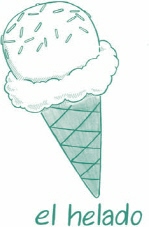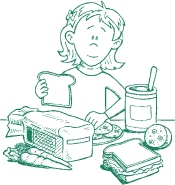
¿Cómo?—
Say What?
¡CUIDADO!
Mistake to Avoid
Depending on where you are, limonada might mean a lemonflavored soft drink like Sprite or 7-Up. If you want lemonade made from actual lemon juice, ask for limonada natural.
Here are some dairy products:
| English | Spanish |
| butter | la mantequilla |
| buttermilk | el suero de leche |
| cheese | el queso |
| cream | la crema |
| cottage cheese | el requesón |
| ice cream | el helado |
| milk | la leche |
| yogurt | el yogur |
Drinks—Bebidas
Now you just need a drink to go with all that great food! Here are some delicious drinks you might enjoy:
| English | Spanish |
| hot chocolate | el chocolate |
| iced tea | el té helado |
| juice | el jugo, el zumo |
| lemonade | la limonada |
| milk | la leche |
| milkshake | el batido |
| orange juice | el jugo, el zumo de naranja |
| smoothie | el licuado (de frutas) |
| soda/pop | el refresco |
| tea | el té |
| water | el agua |
Your parents might have one of these drinks:
| English | Spanish |
| beer | la cerveza |
| coffee | el café |
| espresso | el café exprés |
| wine | el vino |
Dessert—Postres
If you still have room after all of that great food, you can have some dessert. Here are some yummy choices:
| English | Spanish |
| cake | el pastel, la torta |
| candy | el dulce, las golosinas |
| chocolate | el chocolate |
| cookie | la galleta |
| custard | las natillas, el flan |
| donut | la rosquilla, la dónut |
| fritter | el buñuelo |
| fruit | la fruta |
| ice cream | el helado |
| muffin | la magdalena |
| pie | la tarta, el pastel |
| rice pudding | el arroz con leche |
| vanilla | la vainilla |

Consejo
IMPORTANT TIP
Consejo
IMPORTANT TIP
Here are some different kinds of nuts you might find in your dessert:
| English | Spanish |
| almonds | las almendras |
| cashews | los anacardos |
| peanuts | los cacahuetes |
| pistachios | los pistachos |
| walnuts | las nueces |
Now it’s time to practice all the food words you’ve learned. Create a menu with what you’d like to eat for breakfast, lunch, and dinner for one day—in Spanish, of course! Don’t forget to include healthy foods like fruits and vegetables. Fill in the blanks to make your menu:
El desayuno (breakfast)
________________________________________________________________
________________________________________________________________
________________________________________________________________

El almuerzo (lunch)
________________________________________________________________
________________________________________________________________
________________________________________________________________
La cena (dinner)
________________________________________________________________
________________________________________________________________
________________________________________________________________
El postre (dessert)
________________________________________________________________

¿Cómo?—
Say What?
At the Restaurant—En el restaurante
When you go to a restaurant, you need to know more than just the names for food. You also need to be able to order what you want and maybe even explain that you can’t eat certain things. This section will serve as your restaurant survival guide!
To order, you can either say Me gustaría or Quisiera. Both of these mean “I would like” and they are very polite. If you want to ask how much something costs, say ¿Cuánto cuesta...?
If you need to explain what you can and can’t eat before you order, you might find these phrases helpful:
| English | Spanish |
| I can't eat... | No puedo comer... |
| I don't like... | No me gusta... |
| I'm allergic to... | Tengo alergia a... |
| I'm a vegetarian. | Soy vegetariano. |
If you order meat, you might need to specify how you’d like it cooked.
| English | Spanish |
| rare | poco cocida |
| medium | medio cocida |
| well done | muy bien cocida |
Here are some other useful restaurant phrases:
| English | Spanish |
| menu | la carta |
| check/bill | la cuenta |
| tip | la propina |
| tip included | servicio incluido |